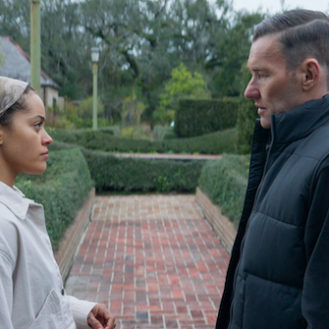I must come clean. I stopped watching the Resident Evil flicks after the second, Apocalypse. I didn’t think the first two outings were bad movies – decent at best – but I stopped watching because they never really appealed to me.
Mind you, this was a time where I didn’t have aspirations to be a film critic and I could be more choosey with what I wanted to indulge in.
Now that I’ve picked this profession, I figure I should see a variety of different things and give different series’ another chance. I went in to Resident Evil: Retribution with a clean slate. I wanted to be surprised and entertained.
That said, the latest film in the action/horror series is silly, and not in the way I wanted it to be. It’s silly in a way where you want it to grow up. Watching Retribution is like meeting up with old sophomoric friends from high school you grew apart from. You’ve changed, but your ex-buddies haven’t matured one bit. They’re still getting high and throwing rocks at passing trains.
Those who are like me and are going into the latest instalment with hardly any knowledge of the series’ running story should feel relieved when the film starts off with a recapping.
Alice (played by Milla Jovovich) explains to us what has happened in previous films while also showing us clips from those prior movies. That introduction is able to supply the broad strokes to the Resident Evil timeline but movie goers, old and new, may still find themselves scratching their heads.
Writer/Director Paul W.S. Anderson has complicated his simple story with lots of talky exposition delivered by actors who look like they’re regretting their decision to star in the film’s fifth chapter.
After being knocked unconscious from an intense action scene that we see in reverse and then forwards (strictly for style purposes to garner “ooh”‘s and “ahhh”‘s from the audience watching this in 3D), Alice is captured by the Umbrella Corporation and is being kept in an underwater base, that’s used for testing purposes.
The base is split up into numerous segments that emulate a certain part of the world. Alice travels from fake New York to fake Russia to a fake suburb. In order to escape to the surface, she must fight her way through armies of zombies to get to the base’s only elevator.
It’s a premise that is filled with so many questions and plot issues. The problems outnumber the large groupings of zombies.
Each setting looks pristine as Alice walks through these scenarios. The amount of detail applied to the various sets is abundant. Alice is told that each segment covers a handful of blocks located in this part of the real city.
The Umbrella Corporation could have all the money in the world to fund their company and keep making poisonous undead members, but I have a terrible time believing that an operation like this could exist and be funded without a single problem.
When zombies and monsters attack, the city is torn apart. Cars are flipped over, glass is shattered, and lots of damage is done. However, the film is very careful it doesn’t block its product placement (by having the New York set take place in Times Square, it’s given the film major opportunities to plaster ads everywhere).
How are these sets reset? Do they bring in an overnight crew for cleanup? For every car and bus that’s totaled, does Umbrella have to buy new ones?
Plus, one elevator? Umbrella needs their budget sorted out. I would think installing more than one emergency elevator would be more important than towering ads for Rebok’s new kicks. Especially since the base is underwater.
I realize I’m looking far too deep into the film but I expect a peppering of sanity and a clear mind even in the most bubbly motion pictures. Anderson obviously hasn’t thought through this futuristic circumstance, leaving his script to be plagued with goofy questions that could’ve easily been solved during the writing process.
Alice also finds out that the humans in these simulations are clones and that Umbrella are using similar people in these repetitive action scenarios to fight or be killed by the undead .
If that’s not a perfect allegory for this overdone series, I don’t know what is. A corporation that manufactures similar looking zombie attacks, using dead-eyed stars as the victims. If you listen carefully, you can almost hear the film have a self-referential sense of humour.
Resident Evil: Retribution is also one of these films where the actors left emotion at the craft service truck and took stalks of celery to replace this void. When Alice and company are gunning down zombies, not one ounce of frightfulness or excitement is seen anywhere.
In the film’s defence, maybe these characters are so used to killing that they don’t think twice about it now. They’re numb to the violence.
However, audiences grow numb as we see the same people kill these deadly creatures with one or two shots of their gun. Not exactly the most thrilling way to kill a zombie.
In other films, we’ve seen zombies blown up, torn apart, and obliterated in the craziest ways. When we see the same dull people shoot countless enemies in the head with ease, that’s not a fun watch – it’s a boring one. Especially when each action scene is needlessly over-stylized utilizing lots of slow motion effects, fast cuts and zoomed cinematography, and those 3D effects that pander directly to those who paid an extra surcharge.
A movie like Retribution reminds me of why zombie guru George Romero gets away with making the occasional bad movie.
Romero is always trying new things with his zombies and I have a feeling he has a teensy bit of doubt when writing these new zombie epidemics. Because of his realization that not everyone is going to like what he divvies out, Romero’s bad movies are forgivable because he listens to his fans and will stop focusing on whatever zombie he’s conjuring up, if it’s too similar to his failure. He’s always moving on to new ideas.
Although he hasn’t directed every Resident Evil movie, Paul W.S. Anderson has been involved somehow with each outing.
There’s a certain type of self-righteous bunk that is layered into the latest installment. Instead of listening to fans, Anderson is listening to box office receipts. If it makes money and the fan base following the long-running video game is down for another cinematic installment, Anderson isn’t going to change anything about Resident Evil.
Anderson feels like he’s doing everything perfectly and, thus, doesn’t change the tone or pacing in his zombie flicks. That doubt Romero has isn’t wired into Anderson – he’s set on delivering the same generic, uneventful action to the loyal fans because that’s what everyone has grown used to and what guarantees a smashing opening weekend from the Resident Evil hardcores.
Because we’ve seen so many creative takes on the undead, this by-the-numbers-regular-ole-shoot-em-up plays as banal and safe.
This return to the Resident Evil films hasn’t been a good one for me. Anderson is doing the same ole’ stuff that pushed me away from the series and made me realize that these action films may not be for me.
The only way I really see Resident Evil: Retribution being a good movie in my eyes is if I was nine and I hadn’t seen another movie. It’s something that would’ve pleased an adolescent me.
However, I expect more now, other than endless scenes of the same repetitiveness. If anything, I expect mindless entertainment out of a film like this. Unfortunately, Resident Evil: Retribution is light on the entertainment and heavy on being mindless.




Leave a comment